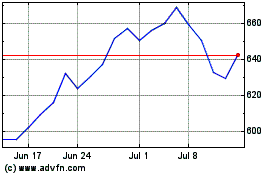Intuit CIO: Be Strategic About the Bots You Build
April 11 2019 - 2:25PM
Dow Jones News
By Sara Castellanos
Automation has become a top priority for Atticus Tysen, chief
information officer of financial software company Intuit Inc.,
which is using software robots to automate repetitive tasks in the
finance and human resources departments.
Mr. Tysen, who has helped lead employee-facing automation
efforts at the company for the past two years, says several
software robots are helping some employees do their work faster and
more accurately. The bots also free employees to focus on "higher
order" work, he said, such as managing relationships with
vendors.
But he has learned some valuable lessons about automation along
the way. Among them: consider carefully which processes need to be
automated. "You don't want to deploy tons of bots, because you're
going to automate bad processes. It's important to be strategic
about which bots you build, " he said.
So-called robotic process automation is being used across
sectors including finance, manufacturing, telecommunications and
retail, in divisions ranging from IT departments to human resources
and accounting. The bots -- some of which incorporate artificial
intelligence -- perform tasks that could include anything from
transferring information to disparate databases to compiling
reports.
Eighty-five percent of CIOs are investing in automation software
deployments over the next two years, according to the 2019 CIO
Survey from Grant Thornton LLP in partnership with the Technology
Business Management Council. Seventy-five CIOs were surveyed from
companies that ranged in size from fewer than 1,000 to more than
10,000 employees.
At Intuit, software is automating a portion of the purchase
order process in the finance department and automatically approving
routine expenses.
Mr. Tysen, still an early adopter of software robots, shares
below the best practices for developing and deploying the
technology.
It can't be IT-driven. Development, deployment and support for
software robots needs to come by partnering with different business
divisions, Mr. Tysen said. "There has to be some business partner
that wants to have the process improve," he said. Partnerships help
IT learn about the intricacies of the business process that needs
automating, and they help the business have a stake in the outcome,
he said.
Start with a small team. Intuit created a small "center of
excellence" of about five people that focused on automation
projects. This was important in order to avoid the creation of
multiple automation platforms, he said. It also helped establish
governance and oversight. Part of the team's job was to monitor the
health of the bots to ensure they didn't have bugs and weren't
using too many computing resources.
Teach the business how to build bots. The five-person team
worked with the finance and human resources departments to build
the first bot. Then, the business divisions built the bots on their
own. "It's about IT creating the capability for the company and
stewarding, teaching and igniting the passion for different teams,
and then figuring out what makes sense for them," Mr. Tysen
said.
Rethink how a process works. The biggest challenge is getting
employees from various business divisions to step back and rethink
how a specific process works and which parts of it should be
automated, Mr. Tysen said. "You don't want to re-engineer the whole
process," he said. Automating certain parts of the approval of
expense reports made sense because approving expenses can be
repetitive and mundane for managers, he said. The automation
software flags routine expenses so managers can skip over those and
focus on expenses that might need more attention.
Write to Sara Castellanos at sara.castellanos@wsj.com
(END) Dow Jones Newswires
April 11, 2019 14:10 ET (18:10 GMT)
Copyright (c) 2019 Dow Jones & Company, Inc.
Intuit (NASDAQ:INTU)
Historical Stock Chart
From Mar 2024 to Apr 2024

Intuit (NASDAQ:INTU)
Historical Stock Chart
From Apr 2023 to Apr 2024
